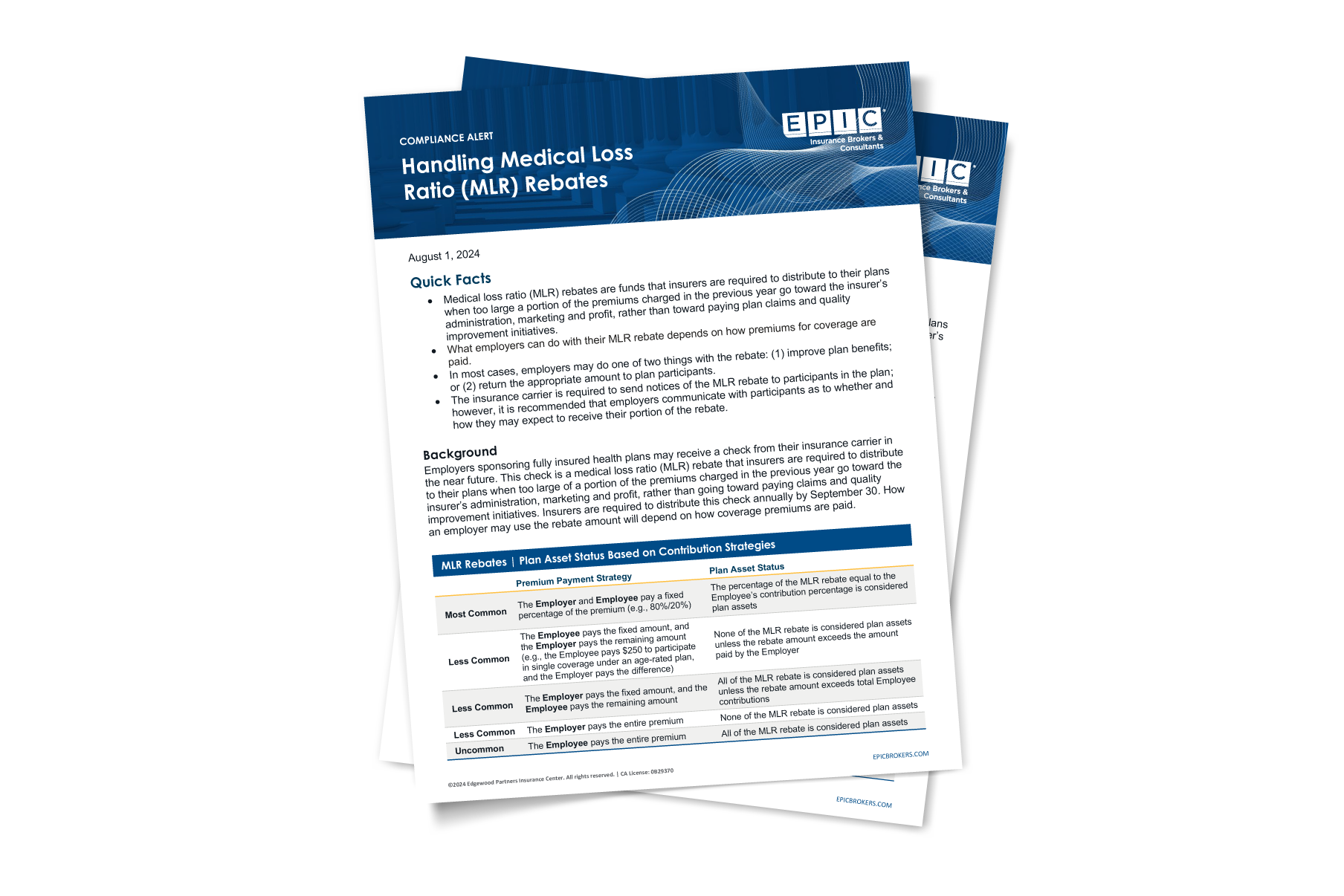Let our team help you navigate the ever-changing benefits compliance landscape each month. Check out this month’s latest alerts, additional updates, and resources hot off the press:
Employee Benefits Compliance Alerts
This month’s Compliance Matters newsletter provides a comprehensive review of the following topics. To obtain your copy, please use the form below to download.

- DOL Releases Final Rules for STLDI & Fixed Indemnity Plans
- IRS Revisits Tax Treatment for Certain “Wellness” Arrangements
- New IRS Guidance for Work-Life Programs
- CMS Final Rule Limits Medicare Advantage Compensation for Brokers & Agents
- Change Healthcare Cyber Attack: Update & Next Steps
- 2024 State Regulation Series: California Dental SBC Requirement
Download this month’s alerts
Additional Updates & Resources
RxDC CMS Portal Now Open for Submissions
On April 10, 2024, the Centers for Medicare and Medicaid Services (CMS) announced through the CMS RegTap portal that the Health Insurance Oversight System (HIOS) is now open to Prescription Drug Data Collection (RxDC) submissions for the 2023 reference year. CMS has updated multiple resources on RegTap for the 2023 submission. Any plan sponsor submitting the RxDC report on their own must be registered with HIOS. While this is a one-time registration, the first time can take several weeks, so plan sponsors are encouraged to register early. The 2023 reference year submission is due June 1, 2024. CMS resources can be located here:
2025 Notice of Benefit & Payment Parameters & Corresponding FAQ Guidance
In March 2024, the Department of Labor (DOL), the Treasury, and the Department of Health and Human Services (HHS) collectively referred to as the Departments, released the finalized 2025 Notice of Benefit and Payment Parameters (NBPP) regulations. The guidance generally focuses on the administration of the public Marketplaces, but also provides significant clarification on coverage requirements for prescription drugs. The regulations require that any prescription drugs covered in excess of the minimum number of drugs required to be covered under a state’s benchmark plan are required to be covered as essential health benefits (EHBs) unless the coverage is provided solely to comply with a state coverage mandate. This means that prescription drugs covered under a group health plan cannot be categorized as non-EHBs subject to annual or lifetime dollar limits or excluded from maximum out-of-pocket limits.
While the guidance is focused primarily on coverage requirements for non-grandfathered individual and small group fully insured plans, a corresponding frequently asked question (FAQ) released on the same day as the NBPP, suggests additional guidance is coming that will extend similar rules to large fully insured group health plans and all self-funded group health plans. The FAQ clarifies that certain prescription drug EHB requirements may impact employer-sponsored group health plans, and that the regulations in the NBPP that codify excess prescription drugs being covered as EHBs do not apply to large group market and self-funded health plans. The Departments intend to propose rulemaking to require large group and self-funded plans to treat prescription drugs covered by the plan or in excess of the applicable EHB benchmark as EHBs. This means these plans will be expected to comply with the Affordable Care Act (ACA) cost-sharing requirements and limits on annual and lifetime maximums.
CMS Releases Redesigned Medicare Part D Notice & Instructions
The Centers for Medicare and Medicaid Services (CMS) released the 2025 Medicare Part D prescription drug parameters for creditable coverage. These benefits are being updated to reflect changes required by the Inflation Reduction Act that will go into effect on January 1, 2025. Plan sponsors must determine whether prescription drug coverage offered to plan participants is creditable and provide notice of that creditable coverage status to both the plan participant and CMS. The Inflation Reduction Act changes the structure of Medicare Part D which may affect whether a group health plan’s coverage is creditable. Some of the changes are:
- New definitions the standard Medicare Part D benefit
- A lower out-of-pocket maximum limit of $2,000, which is a substantial decrease from $8,000 in 2024
- A higher deductible of $590 in 2025, a slight increase from $545 in 2024
- A new Manufacturer Discount Program
Some plan sponsors have historically relied on a simplified method for determining whether prescription drug coverage provided under a group health plan is creditable. Prescription drug coverage meeting certain standards as defined in the simplified method provided back in 2009 is deemed creditable. Recent guidance via final instructions from CMS allows the use of the simplified method through 2025 but suggests there may be changes in 2026. In addition, for the many plans (e.g., HDHPs) that do not meet the simplified method and that must determine creditable status on an actuarial basis, the increased coverage available via Medicare Part D beginning in 2025 may cause more plans to be non-creditable.
For more information, refer to the Announcement, Instructions, and Fact Sheet provided by CMS.

More Compliance Resources
- Sign up for our in-depth 2024 Compliance Webinars
- Learn about our Compliance Consulting Services

WANT TO GET COMPLIANCE MATTERS IN YOUR INBOX?
Sign up for the monthly newsletter.
